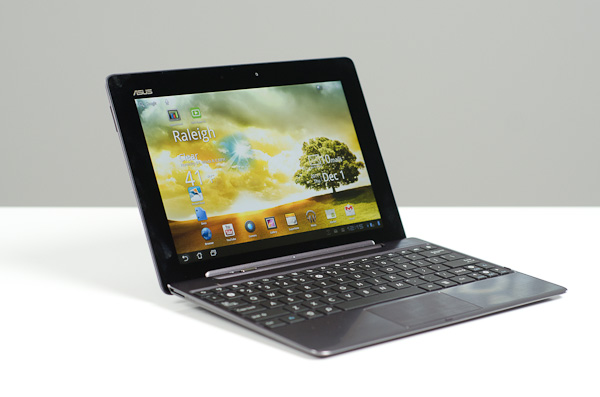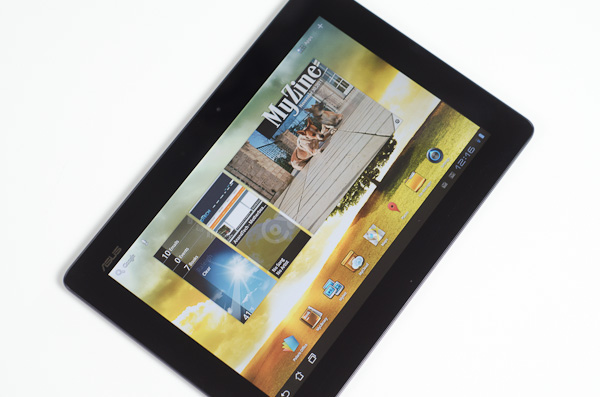ASUS Eee Pad Transformer Prime & NVIDIA Tegra 3 Review
by Anand Lal Shimpi on December 1, 2011 1:00 AM ESTFinal Words
Assuming the WiFi and minor dock issue I encountered aren't widespread (ASUS insists they aren't), I am comfortable calling the Eee Pad Transformer Prime the absolute best Android tablet on the market today. The hardware looks and feels great. ASUS picked the best display possible and married it to some really good industrial design. I was impressed with the styling of the Zenbook, and the Prime continues to position ASUS as a purveyor of high quality mobile devices.
At the same time, NVIDIA has finally delivered an SoC capable of delivering the sort of smooth experience we'd expect from a $500 tablet. Honeycomb was a great first attempt by Google at a tablet OS, but Tegra 3 really makes the whole experience complete. Everything you'd expect to be smooth, is finally smooth. Video playback is no longer an issue, the Prime and Tegra 3 can finally play back virtually anything you'd want to throw at it. Thank goodness.
As good as the combination is today, I admit that I still can't wait to put Ice Cream Sandwich on this thing. Even more polish on the OS side (and the absence of any hardware issues during the testing process) would've easily catapulted the Prime into editor's choice territory.
Battery life is the big unknown at this point. At worst it's roughly on par with the old Eee Pad Transformer. I'll know more in the coming days, but 9 hours of continuous use isn't bad. The question is how much better will it be as we start playing with the available power options? I'm also curious to see what having four cores does to web page loading performance. There's clearly an impact on JavaScript rendering, but what about the overall real world experience? In my testing I was limited by the WiFi issue I mentioned earlier, but I hope to have an answer to this soon enough.
The inevitable iPad comparison is, well, inevitable. I still firmly believe there's not a whole lot of iOS/Android cross shopping. If you want an iPad, that's what you should buy. Android isn't an iOS substitute, just as iOS isn't an Android substitute. You can do similar things on both, but personal preference will really determine what suits you the best.
I'll have more coverage on the Prime over the coming days, but if you're making your decision before then: this is the Android tablet to get.
Update: ASUS has removed GPS support from the Prime's official spec sheet. Check out our update here as well as our follow-up to the review.












204 Comments
View All Comments
thunng8 - Thursday, December 1, 2011 - link
It would be pretty hard to beat the visuals of Infinity Blade II on the ipad2. The game looks amazing.TrackSmart - Thursday, December 1, 2011 - link
Anand,Just a heads-up, as I know you had to get this review out the door quickly: It would be really useful to put the weight of the tablet AND keyboard dock prominently on the first page (maybe in the chart?). This would make it easier to compare the total travel weight to ultraportables and netbooks.
I'm guessing that we're talking about 2.6 pounds from what I could find online. And you'd end up with some serious battery life (18 hours?) compared to even the longest running Zacate (or Atom) laptops/netbooks. If only the software and hardware capabilities were as good...
biassj - Thursday, December 1, 2011 - link
Asus looking good but tablets can't replace x86 PCs yet. I hope Asus launches a 15" Zenbook with 1080 display and maybe even a quad core Ivy bridge. I don't mind if it's thicker but I want something to compete with the rumor Macbook Air 15".HighTech4US - Thursday, December 1, 2011 - link
Will the ASUS Eee Pad Transformer Prime be retested here when ICS (Ice Cream Sandwich) is released for it?My understanding is that there are improved graphics drivers and other improvements in the OS that will improve on the results shown here.
vvk - Thursday, December 1, 2011 - link
Hi Anand,It seems that the results of the Ipad 2 and Transformer Prime are quite different in GLBenchmark 2.0.3 Egypt (tested by PCworld) vs. what you have found based on the vs. 2.1 of the same benchmark. Could you comment what may be the reason for the differences?
"The most significant result in our gaming performance tests: The Transformer Prime logged 53 frames per second, the highest frame rate we've seen on the GLBenchmark 2.0.3 Egypt test with no antialiasing. This result topped the Apple iPad 2's previous record of 46 fps, and it just crushed the Android masses we've tested, which averaged 18 fps and topped out at 34 fps (for the 7-inch Acer Iconia Tab A100)."
https://www.pcworld.com/article/245256/asus_eee_pa...
vvk - Thursday, December 1, 2011 - link
Also wanted to add that other sites show much longer battery life for the Transformer. I understand that the battery life depends on use but could be that your unit is a dud in not only in case of WiFi but also battery, so I wonder if you would be willing to repeat the battery test?Anand Lal Shimpi - Thursday, December 1, 2011 - link
I'm already on it :) Got a new Prime in this morning and battery life is looking much better already.Take care,
Anand
metafor - Thursday, December 1, 2011 - link
The tests in the article were done using an off-screen resolution of 1280x720. This allows all devices to be tested at the same resolution -- thus measuring the relative rendering performance of the SoC.Looking at the results on GLBenchmark's own website:
http://www.glbenchmark.com/result.jsp
Correlate to what is posted in the article.
The ones posted by users of Tegra-3 devices:
http://www.glbenchmark.com/phonedetails.jsp?benchm...
Also correlate with the results of the article. I suspect that version 2.0.3 may stress different parts of the GPU or that PC World got some pretty bad results.
vvk - Thursday, December 1, 2011 - link
Well I usually do not play games off-screen :) Anyway, I am still puzzled what is causing the huge difference between the 2.0.3 Egypt vs. 2.1 (assuming both test were done correctly).Also while comparing Ipad 2 at theoretical 720p has merits in synthetic testing in practice you can not see more than 1024 by 768 pixels on the Ipad 2.
I am also wondering if GLBenchmark better than lets say 3dMark for desktop? 3D Mark scores do not always correlate perfectly with real games experience due to optimizations for particular card and also because synthetic testing is not a perfect substitute for real games to start with. So I am not overly concerned about the scores more about what have changed between the GLBenchmark versions.
metafor - Thursday, December 1, 2011 - link
Absolutely. But unfortunately few games for mobile if any offer time-tests and there is no equivalent framerate tool like FRAPs to measure framerate in real games.So synthetic benchmarks will have to do for now.
As for 2.0.3 vs 2.1, GLBenchmark's website doesn't give all too much info except that it includes the off-screen mode as well as "high quality" versions.
But it does mention that 2.1's throughput tests -- which I don't think impact Egypt -- perform warm-up loops in order to cache a lot of its data before measuring GPU throughput.
Other than that, I'm not really sure what changed.